Human body consists of a large number of muscles, with each one being different from the other, operating and behaving in a different way. Therefore, we classify the human body’s muscles into basic categories / muscle fiber types, for facilitating the training guidance.
The main goal of a workout is muscle hypertrophy, meaning bulking and muscle mass.
As you get to know your body and the way it works better, significantly better and faster results may be achieved.
Muscle Training
Here is a brief anatomy lesson for starts. You should know that the body’s skeletal muscle is made up of “clusters” of muscle fibers. The muscle fibers consist of many multi-core cells.
Muscle fibers have a cylindrical structure with a variable thickness based on their usefulness and function in human body.
The so-called “hypertrophy” of the muscles caused by physical exercise is due to an increase in the diameters of these cylindrical structures of cells (muscle fibers).
On the contrary, if the person follows a sedentary lifestyle and the muscles undergo chronic immobilization, the thickness of the muscle fibers gradually weakens.
In the past, theories supported that there were “fast” and “slow” categories of muscles. But now (since the middle of the 20th century) – and with the assistance of technology & various very detailed methods – it is clear to scientific community that the types of muscle fibers are not 2, but 3.
Furthermore, to slow and fast muscle fibers, there is another category expressing something between these two.
The types of muscle fibers differ at different levels (normal, functional, morphological, and chemical) and this is what differentiates their final function in human body.
Muscle Fiber Types

1st Type: The Slow Muscle Fibers
These muscle fibers (of slow contraction) have a high concentration of mitochondria and myoglobin. They are smaller, and usually surrounded by many capillaries, giving them the ability to be more resistant to strenuous fatigue and long-term muscle exercise.
These muscle fibers – also called oxidants – have a low excitation limit and ensure low body muscle contraction with low contractile intensity.
The amount of energy required, however, is high enough to tolerate fatigue and constant use.
2nd Type / 1st Category: Fast Muscle Fibers
In the second category, the fast muscle fibers (of white color), or otherwise glycolytic muscle fibers are included. These show intense contractions, intended for short-term use.
Their stimulus limit is much higher than slow muscle fibers, a sort of “emergency muscles”.
The amount of energy required is also very large, but for completely different reasons compared to the slow muscle fibers. While in the slow fiber muscles the energy is necessary for their continuous and low operation, in fast ones it is necessary for short-term use, but of very high efficiency.
Therefore, in case of a sprint, you will use the fast muscle fibers allowing you to quickly start up and achieve an increase in your time efficiency.
2nd Type / 2nd Category: Intermediate Muscle Fibers
These come as a combination of slow and fast muscle fibers. These are the body’s red muscle fibers used in both low and high-intensity activities, concerning aerobic and anaerobic body move, presenting a higher tolerance to fatigue, compared to the fast muscle fifers being exhausted in a very short period of exercise.
They have a low contraction rate and slightly higher oxidative metabolism.
I have all 3 Muscle Types?

In general, the human body presents a combination of slow & fast muscle fibers intended for different uses.
However, this does not mean that all people have the same number of fast and slow muscle fibers in their body, with their number depending on lifestyle and physical activity.
A person running a marathon, for example, will develop a large number of slow muscle fibers increasing its endurance in long-term physical exercise, unlike a person running a sprint developing a large number of fast muscle fibers providing great performance for a short period of physical exercise.
Finally, what happens with a person following a sedentary lifestyle?
People who are not used to exercising present in average a proportion of fast and slow muscle groups.
Training Depending on the Type of Muscle Fibers

As already mentioned, the proportion of fast & slow muscle fibers developed in our body may be determined (to an extent) by the type of training performed.
Endurance training has completely different requirements from strength training, requiring different muscle fibers to achieve results.
An HIIT workout, for example, will activate fast muscle fibers (short-term and high-intensity training), while LIIT workout activates the slow muscle fibers (long-term & low-intensity training).
Certainly, there are other parameters also determining the final athlete’s performance in training. Age is one of those additional factors, playing a role in the effectiveness of the training process.
Finally, it is mentioned that both the volume and intensity of training also determine the athlete’s evolution, as well as its final training benefits (muscle gains, performance, endurance, etc.).
Muscle Hypertrophy Depending on the Type of Muscle Fibers
Hypertrophy does not occur in the same way in fast muscle fibers, as in slow muscle fibers.
Besides, a sporadic workout is not enough to achieve muscle hypertrophy. Systematic training is required, with consistent and gradual increase in requirements.
The constant “workout” of the muscles brings eventually their strength and increase of the volume desired.
However, to have this happen takes time, discipline, patience and dedication, with the time required to achieve muscle hypertrophy also varying from one type of muscle fiber to another.
Some muscles have significantly lower response time to exercise, while others require more effort (something probably already noticed in practice from your workouts).
How I Select the Training Type?
As discussed earlier, a person not exercising, usually presents a proportion of fast and slow muscle fibers.
This practically means that the selected training is not based on the muscle fibers of your body, but on the contrary, you select the training best for you, your character and your requirements, shaping your muscle fibers over the time depending on the type of training selected.
At which Muscle Fiber Type targets each Workout?

In general, we classify the various training / sports activities into categories depending on the muscle fibers “targeted” at each activity.
Therefore, athletes involved in marathons, running, walking, swimming, cycling are aiming more at the body’s slow muscle fibers, without this meaning for example, that there are no swimmers or cyclists using their fast muscle fibers for developing speed in a short period of time.
It’s rather complicated.
Virtually every type of workout has different requirements from the muscular system in general, but the result is measured even by how the exercise selected is applied.
Weight lifting, for example, is aiming more at fast muscle fibers to withstand the lifting of heavy loads.
Even when you just go for jumping an obstacle in your way, your body turns to fast muscle fibers to do a fast jump, requiring high amounts of energy (with no long duration required in its application).
On the contrary, – in order to make the separation completely understandable – an action that you perform for a long time during the day (whether concerning sports or daily activities) requires help from your slow muscle fibers for providing the body with the required energy over time.
The marathon is one such example of slow muscle fibers use. A typical example, however, is the general assurance of the human body move throughout the day. Every time you move any part of your body, you expend energy using the slow muscle fibers.






